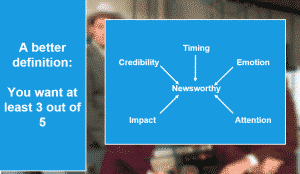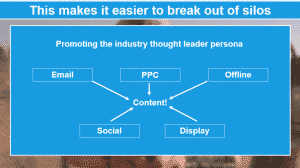The concept of newsworthy content is one that every brand should be chasing. The phrase “great content” is a widely used one but by its nature it’s extremely difficult to actually qualify as it’s rather subjective and extremely broad! In a lot of cases I much prefer to use the term newsworthy as it identifies with the ideas behind the content rather than the production value and delivery. There’s no reason why any brand can’t create newsworthy content on a relatively low budget, something that can be shown in the examples given throughout the presentation.
The components of newsworthy content
In order to be able to classify content as newsworthy we can distil the concept into 5 separate areas – timing, emotion, impact, attention & credibility. In order to have a content piece that can be classed as newsworthy it needs to fulfil at least 3 of these areas:
- Timing – Is the information contained in the article fresh? Or does it relate specifically to a fresh event?
- Emotion – Does the piece invoke some kind of emotion within the user? Be it happy, sad, angry or joyful, does it make the user feel something?
- Impact – How does the information impact the user? Is it relevant to their everyday lives or will they behave differently having read and understood the information?
- Attention – Does the content grab the user’s attention? Is the subject and information sufficient to pull them away from what they are doing to focus their attention on the piece?
- Credible – Should the user trust the information contained in the piece? Does it contain statistics to back up the content and are these statistics reliable? Or does the piece have involvement from someone who is sufficiently qualified or recognised to talk about the subject?
Applying this framework to all content that’s produced will immediately start to qualify the content that you produce as newsworthy or not and enable you to look at what aspects it might be missing to become newsworthy.
How a brand can become newsworthy
Publishers and newspapers create tons of fantastically newsworthy content on a daily basis but that is largely because they are built to do so – that is the core part of their business. Whilst there’s a great deal more going on with a brand, understanding that the creation of newsworthy content requires ingrained processes is the first step to being able to continuously do it!
The Marketing management process is something that is taught at business and marketing schools as a tool to manage campaigns in a structured format. This is broken down into 5 steps:
- Analysing market opportunities – understanding the audiences out there, how they behave and what they want
- Selecting target – deciding which audience segment to target
- Designing the market strategy – Formulating a strategy to engage with that target segment
- Plan & implement marketing programs – conceive & produce the campaigns that targets the segments
- Manage marketing efforts – Ensure that the campaigns are properly promoted and managed according to the KPIs and business goals
This 5 stage process is very similar to what content marketers cite as the 3 stage content marketing process: Strategy, Production & Promotion. The first 3 of the Marketing Management Process relates to Strategy, the fourth relates to production and the fifth relates to promotion.
The important thing to realise is that over half of the Marketing Management Process is covered under the strategy section. From properly identifying your target audience to formulating the strategy to target them, the strategy section of the content marketing process is the most important to get right in order position yourself to continuously create newsworthy content.
This is where lots of campaigns tend to fall over, they rush in to the production phase without paying sufficient attention to creating the strategies to create newsworthy content that sufficiently targets their audiences.
So by creating a strategy and strategic processes for your overall content campaigns, less ongoing resources need to be placed on how individual campaigns are carried out, which means more resource can be placed on what the campaigns are, which is the area that makes them newsworthy.
And once our content is newsworthy it makes it much easier to break it out of the link building silo as other channels can be utilised to market the content and messaging. This kind of content is not a channel, rather it is a central message that the brand’s audience can engage with, promoting the brand’s image as an industry thought leader. Therefore it can be used within all the other channels to improve their performance and create a cohesive brand image.
Within each channel, we can also change slightly the way that the content is framed to coincide with the kind messaging that performs well within that channel. This will help to better align the activity with the business’s KPIs – exposing users to the brand in order to increase their propensity to convert. Because it is that level of engagement with the content that really makes it newsworthy for the brand!
How do we create newsworthy content?
So understanding what newsworthy content is and the need for processes in order to create it, is an important step to take but tactically what can we do to enable the marketing team to start continuously creating content that is newsworthy? Here are some tips to get started, check the presentation for examples on each of these:
Stop thinking copywriters – think influencers
Too many companies are still using copywriters to create all of their content when really users want to see knowledgeable influencers imparting information to them.
There are different kinds of influencers that fit different kinds of content campaigns, these can be categorised into 4 types:
- Brand marketers – These are marketers who are there to illustrate data and updates from the brand. They represent the brand itself.
- Brand journalists – These are the frontline journalists who keep their ears to the ground to provide commentary on industry news and trends. Their job is to find the stories and relate them back to the brand’s audience.
- Customers – if you’re not seeing your customers as influencers then you are definitely missing a trick! These are people who experience the products and are ingrained in your industry so listen to them and enable them as story tellers.
- Influencers – your influencers are your experts. They may live external to your business but their job is to be utilised as brand advocates, writing content and inspiring your audience to your brand.
Understand what assets are available
As many will probably know, creating something from nothing is extremely difficult, which makes it highly important to fully understand what is available to you before you begin the creative process. Your assets can range from a number of things but data & knowledge will probably be the most valuable, these are great to leverage as you can use them to add credibility and perspective to the content you produce.
Data can be found in a number of places external to your business and it doesn’t necessarily have to be new. Look at old studies and compare them with other datasets, pivot them to gain new insights or flip them on their head to say something different – the great thing about data is that it is so reusable!
Having said that, there is also a lot of value in other forms of assets as well. Being a particularly creative brand (or have particularly creative people) will enable you to create campaigns that are much more likely to go viral by focusing on the attention quality. Imagery & the facilities to get imagery can make your content much more emotional or credible whilst leveraging website coding abilities can make tools that have an impact on your audience. Be broad in your search for assets as they can turn up in the most unlikely of places.
Stay on top of the industry
This one is very process driven as new developments and stories will happen when you least expect it, and a good, process driven, marketing team will already have the strategy and frameworks in place to be able to jump on this with a minimal lead time.
Use Twitter & RSS feeds as much as you can, create targeted Twitter lists, use social media monitoring tools to listen and be ready to react when things happen.
You can also utilise media enquiry services such as HARO, Response Source or PR Newswire to keep connected with journalists but also take this further and meet people within the industry who are creating the stories – this means going to events outside of SEO and getting to know people who can turn to you as industry experts to add value to stories that they might break.
But be careful with newsjacking
Newsjacking can be a great way to get in on a conversation and tap in to a new audience, but if it’s done badly then you will either get lost in a lot of noise or worse, it will make you look foolish!
What you need to remember when conducting a newsjacking campaign is that you should leave the reporting to the newspapers. Instead make sure that you’re always adding to the conversation in a way that relates the story back to your audience. If you cannot sufficiently do this then question whether you should be covering the story at all as it may be best to stay quiet.
Create a dialogue with your customers
Your customers are a great source of newsworthy content as they are full of stories that revolve around your products. Customer stories, done well, can create awesome, credible content that other users can relate to because they too may be in similar situations, looking for a solution.
Create channels to converse with your customers so that you can find the ones with newsworthy stories. Use surveys, forums, CRM channels, UGC, Gamification, Social Media to talk to and respond to your users out there, and don’t just provide the platform, give uses a reason to engage!
What do you do with newsworthy content?
As marketers, it is all well and good creating newsworthy content and actually the links that it can get you may currently be your main goal. But actually, when you’re in a situation when the majority of your content is newsworthy, the impact of that content is going to extend far beyond the likes, shares, retweets & links that it will get.
The effect of the content will be such that users who are exposed to it will become more informed and closer to your brand than customers than the users who aren’t. They will spend more money, purchase more often and be much more valuable than users who have just picked you up by searching your targeted keywords.
This is the stage where the value of marketing your content through multiple channels comes through – using it for email marketing content, including it in PPC landing pages & offline messaging and leveraging it to engage with audiences on social. The fact that your content is newsworthy will build your authority and so increase the user’s propensity to convert with your business and so their value.
To understand this process you want to be in a situation where users who are at different levels of exposure with the brand and content are targeted differently, with different messaging. This is very tricky to do if users only view your content on external sites, which means that to leverage the value of your content, focus should be placed on enticing the users into owned/shared properties, where we can market more content & messaging to them.
This can be done by encouraging users to follow you on Social media, offering them further content onsite or on microsites (where they can be put on a remarketing list) or getting them to sign up for an email list for more in depth stories. Getting this kind of data is really important for both maximising the effect of the content you produce and also measuring the impact of the campaign.
Then, once you start to properly track users who have been exposed to the content then you can start to segment and compare customers who have seen/engaged with your content vs customers who haven’t, which can give you a much better understanding of how your (newsworthy) content is affecting your marketing beyond link & rank metrics.
I have put the slides up on Slideshare for anyone who wants to recap and there is also plenty of extra stuff in there that I didn’t have the time to go through. I hope people found the talk useful and tweet me if you have any thoughts or questions:





